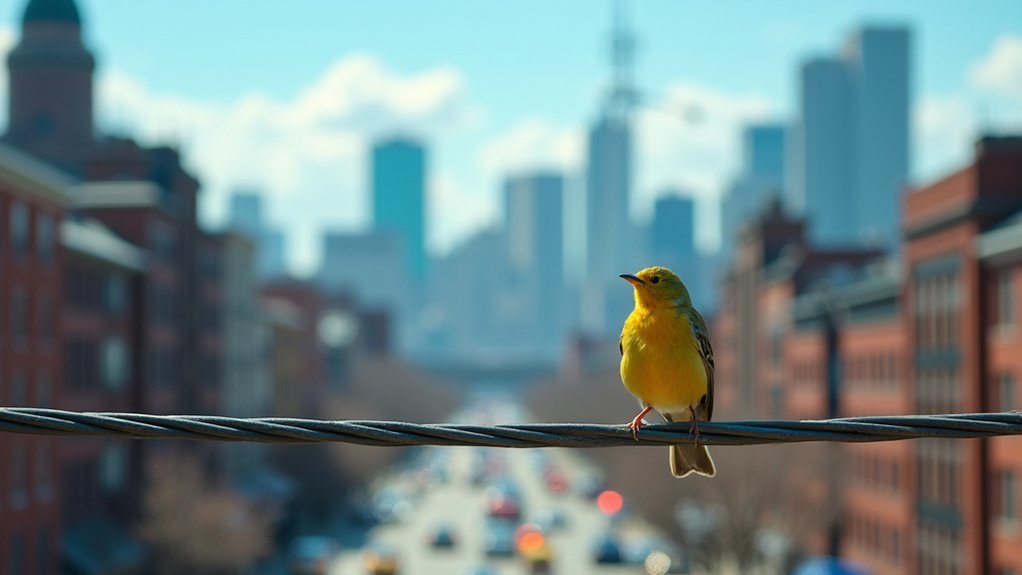Urban birds adapt their songs in three surprising ways to survive city noise. You’ll notice them singing at higher frequencies to cut through traffic rumble, producing fewer song variations on especially noisy days to conserve energy, and extending their songs’ duration despite the greater physical effort required. These clever adaptations come with hidden costs – from increased energy expenditure to potential reproductive challenges. These vocal modifications reveal nature’s remarkable resilience in our concrete jungles.
How Urban Noise Forces Birds to Sing Higher Frequencies

As you walk through a bustling city park, you’ve probably noticed birds singing with surprising clarity above the constant rumble of traffic.
What you’re hearing is a remarkable adaptation: city birds like blackbirds and great tits shift their songs to higher frequencies to overcome urban noise.
This isn’t coincidental. Studies of house wrens in Costa Rica show males sing at higher pitches as noise levels increase.
It’s a clever communication strategy—these elevated songs travel further through the anthropogenic din, helping birds stake territory and attract mates.
But this adaptation comes with costs.
When birds modify their songs for city living, their song repertoire often shrinks.
With fewer vocal variations, their communication becomes less nuanced, potentially leading to reproductive isolation among urban populations.
The Shrinking Song Repertoire of City-Dwelling Species
While urban birds adapt by singing at higher pitches, they’re also experiencing a concerning loss in vocal diversity. You’ll notice that city-dwelling species produce fewer song types on days when anthropogenic noise increases. House wrens, for example, greatly reduce their song repertoire in noisier urban environments.
This diminishing song diversity creates real challenges for birds. With a limited vocal arsenal, males struggle with territory defense and mate attraction, directly impacting their reproductive success.
The consequences extend beyond individual birds—reduced communication between populations can lead to reproductive isolation and potential speciation processes.
The phenomenon reveals urbanization’s broader impact on wildlife behavior. As cities grow louder, our feathered neighbors make do with smaller vocal toolkits, fundamentally altering how they interact and reproduce in human-dominated landscapes.
Longer Songs: The Energy Cost of Being Heard in Urban Environments

Birds living in urban environments face a significant challenge that you’ll rarely consider while strolling through a city park: they must invest considerably more energy into their songs. Species like Spanish serins sing longer songs to overcome background noise, creating a costly trade-off.
| Adaptation | Energy Impact | Survival Consequence |
|---|---|---|
| Longer songs | Higher energy expenditure | Less time for foraging |
| Increased volume | More physical exertion | Greater predator visibility |
| Modified frequencies | Reduced song repertoire | Compromised vocal communication |
When you hear these persistent singers, you’re witnessing their evolutionary response to human-generated sounds. House wrens demonstrate this by reducing their song repertoire on noisier days—a clear survival strategy to conserve energy. These adaptations highlight the hidden costs urban birds pay simply to be heard in your city.
Frequently Asked Questions
Why Do Birds Change Their Songs?
You’ll find that birds change their songs to overcome urban noise pollution. They’ll adapt by singing at higher frequencies, increasing volume, and simplifying repertoires so you can hear them despite city sounds.
How Do Bird Songs Change in Response to Sudden Changes in Their Environment?
When sudden environmental changes occur, you’ll notice birds quickly adjust their songs—raising pitch to overcome noise, simplifying patterns during disruptions, or enriching complexity during quieter periods to maximize their communication effectiveness.
Which Bird Song Produce the Best Musical Effect?
You’ll find no single bird has the “best” musical song. It’s subjective, but thrushes, nightingales, and mockingbirds are often celebrated for their complex melodies, varied tones, and rhythmic virtuosity.
What Effect Does a Birds Song Have on Other Birds?
Bird songs serve as essential communication tools. You’ll see they help males attract mates, defend territories, and establish social hierarchies. They’re also important for species recognition and can warn others about nearby predators.
In Summary
You’ve now seen how urban living transforms birdsong: higher pitches cut through traffic noise, simplified repertoires adapt to acoustic challenges, and longer performances guarantee messages get through. Next time you’re walking city streets, listen for these adaptations. These feathered neighbors aren’t just surviving—they’re evolving their very voices to thrive alongside you in the concrete landscape you both call home.




Leave a Reply